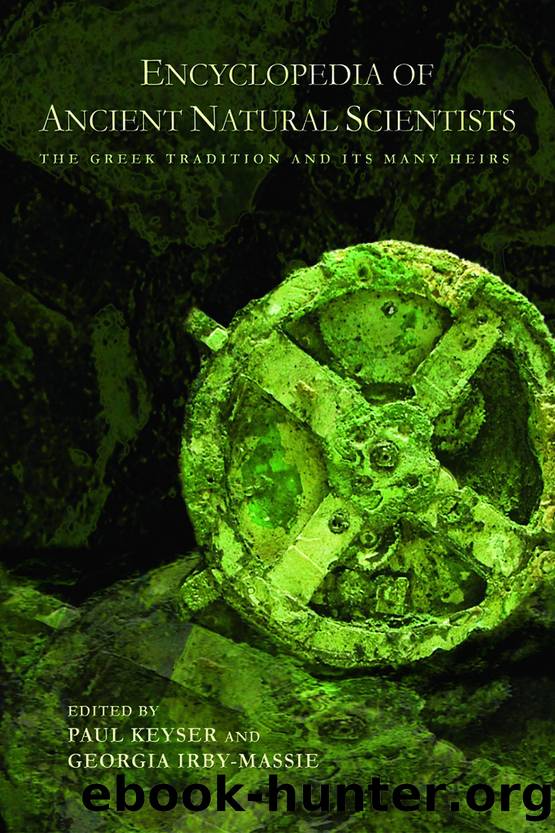The Encyclopedia of Ancient Natural Scientists by Irby-Massie Georgia L. Keyser Paul T

Author:Irby-Massie, Georgia L.,Keyser, Paul T.
Language: eng
Format: epub
Publisher: Taylor & Francis (CAM)
Lingōn (10 BCE – 95 CE)
ASKLĒPIADĒS PHARM., in GALĒN, CMLoc 9.4 (13.286 K.), records his anodyne, based on henbane and opium, and including Cretan-carrot seed (cf. KHARIKLĒS), euphorbia (cf. IOUBA), purethron, and saffron. The name seems derived from the Gallic tribe, cf. POLUBIOS 2.17.7, CAESAR BG 1.26.5–6, 1.40.11, STRABN 4.3.4, 4.6.11, and J.-H. Billy, Thes. Linguae Gallicae (1993).
RE 13.1 (1926) 714, F.E. Kind.
PTK
Linos, pseudo (ca 250 – 150 BCE?)
“Linos” was the lamented, or a song for the lamented, but is listed by HIPPOBOTOS as a sage (DIOGENĒS LAËRTIOS 1.42); Diogenes Laërtios credits him with a verse cosmogony, entitled On the Nature of the World, of which IOANNĒS STOBAIOS quotes two excerpts: 1.10.5 on the essential unity and perpetual flux of all things, and 3.1.70 on avoiding gluttony; cf. Souda Lambda-572 (giving Thebes as the ethnic). He taught a Great Year of 10,800 years, HĒRAKLEITOS’ value (CENSORINUS 18.11), that the four elements were held together by three “bonds” (THEOLOGUMENA ARITHMETIGAE, p. 67 de Falco), and the special significance of the seven planets and seven days (Aristoboulos in Clement, Strom. 5.107.4).
Ed.: West (1983) 56–67.
DPA 4 (2005) 107, B. Centrone.
PTK
Download
This site does not store any files on its server. We only index and link to content provided by other sites. Please contact the content providers to delete copyright contents if any and email us, we'll remove relevant links or contents immediately.
Periodization Training for Sports by Tudor Bompa(7995)
The Body: A Guide for Occupants by Bill Bryson(4706)
The MacArthur Bible Commentary by John MacArthur(4666)
The Sports Rules Book by Human Kinetics(4141)
What It Really Takes to Get Into Ivy League and Other Highly Selective Colleges by Hughes Chuck(3587)
Marijuana Grower's Handbook by Ed Rosenthal(3549)
The Sprouting Book by Ann Wigmore(3462)
The Martian by Andy Weir(3220)
Salt, Fat, Acid, Heat: Mastering the Elements of Good Cooking by Nosrat Samin(3038)
The Bread Bible by Rose Levy Beranbaum(2932)
Sapiens and Homo Deus by Yuval Noah Harari(2898)
Classic by Mary Berry(2877)
Harry Potter 4 - Harry Potter and The Goblet of Fire by J.K.Rowling(2866)
The Marketing Plan Handbook: Develop Big-Picture Marketing Plans for Pennies on the Dollar by Robert W. Bly(2851)
Martha Stewart's Baking Handbook by Martha Stewart(2709)
The Plant Paradox by Dr. Steven R. Gundry M.D(2474)
Screenplay: The Foundations of Screenwriting by Syd Field(2465)
50 Economics Classics by Tom Butler-Bowdon(2448)
The Cambridge Grammar Of The English Language by Rodney Huddleston Geoffrey K. Pullum(2336)
